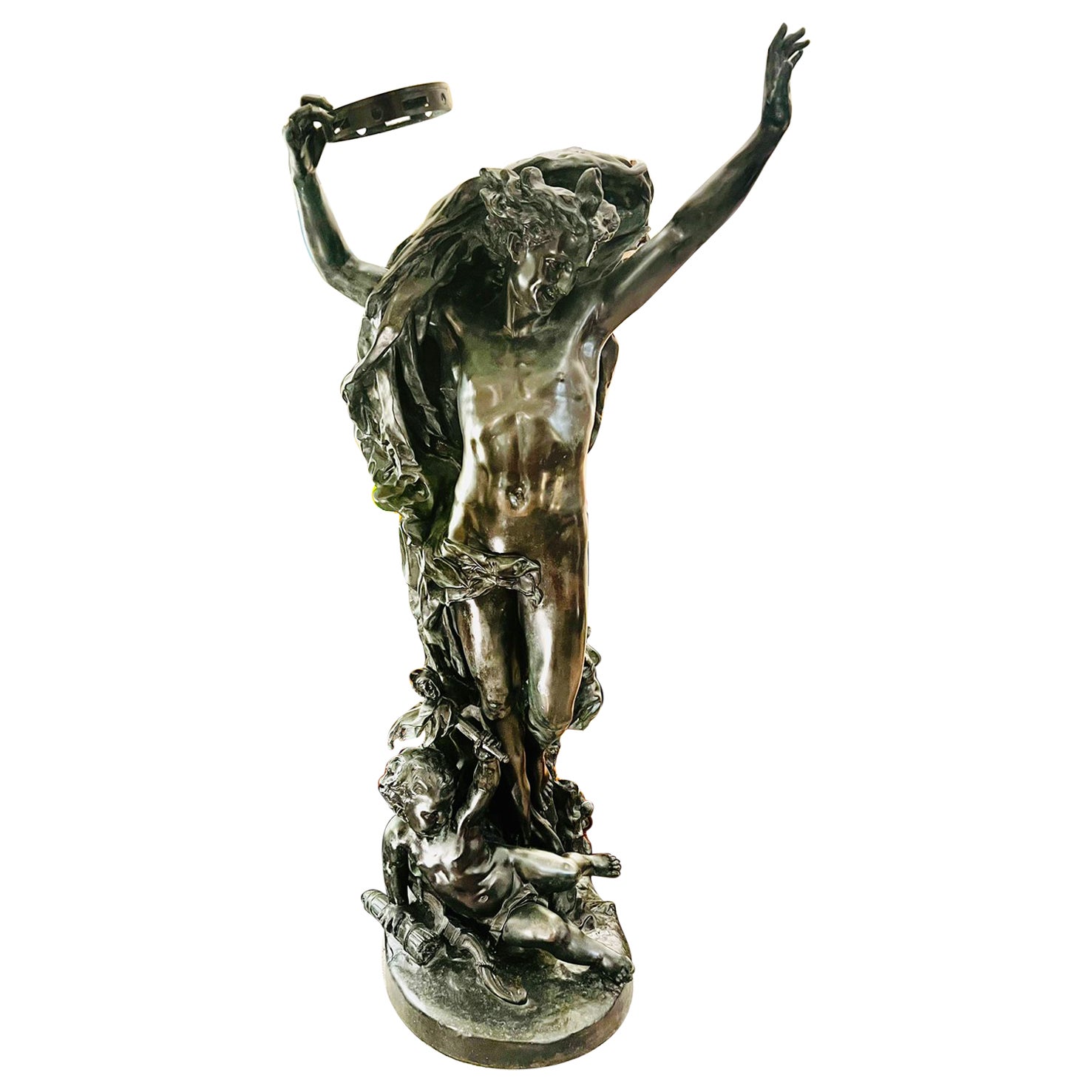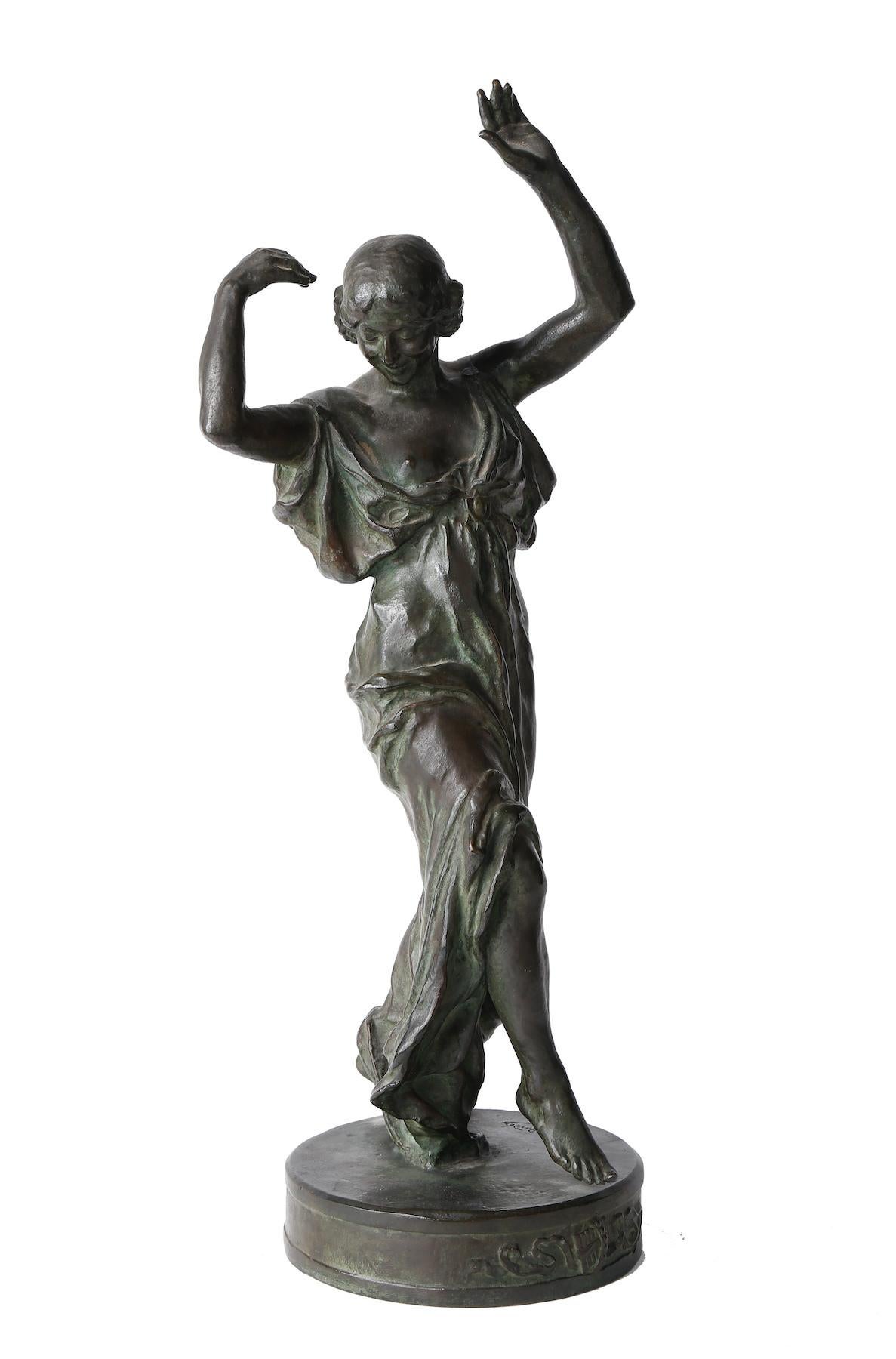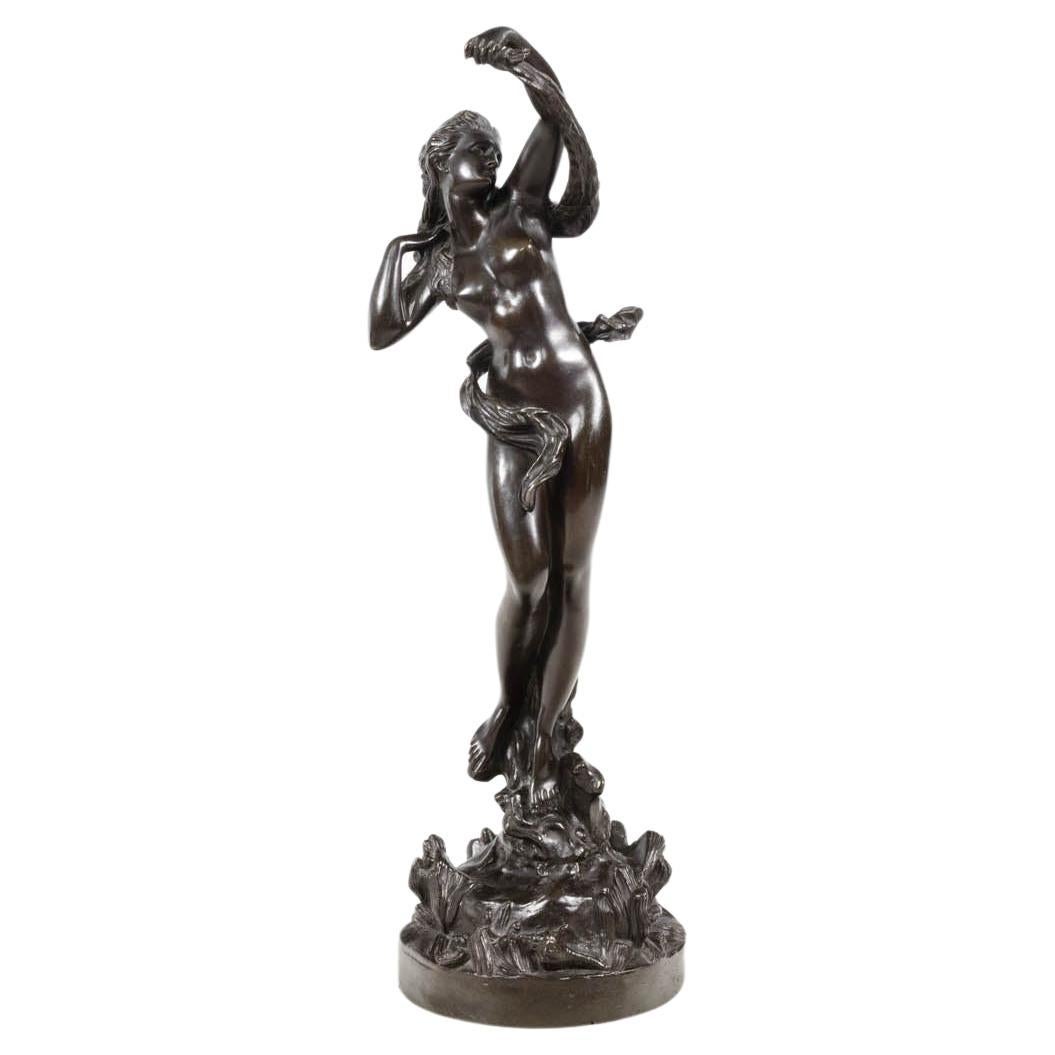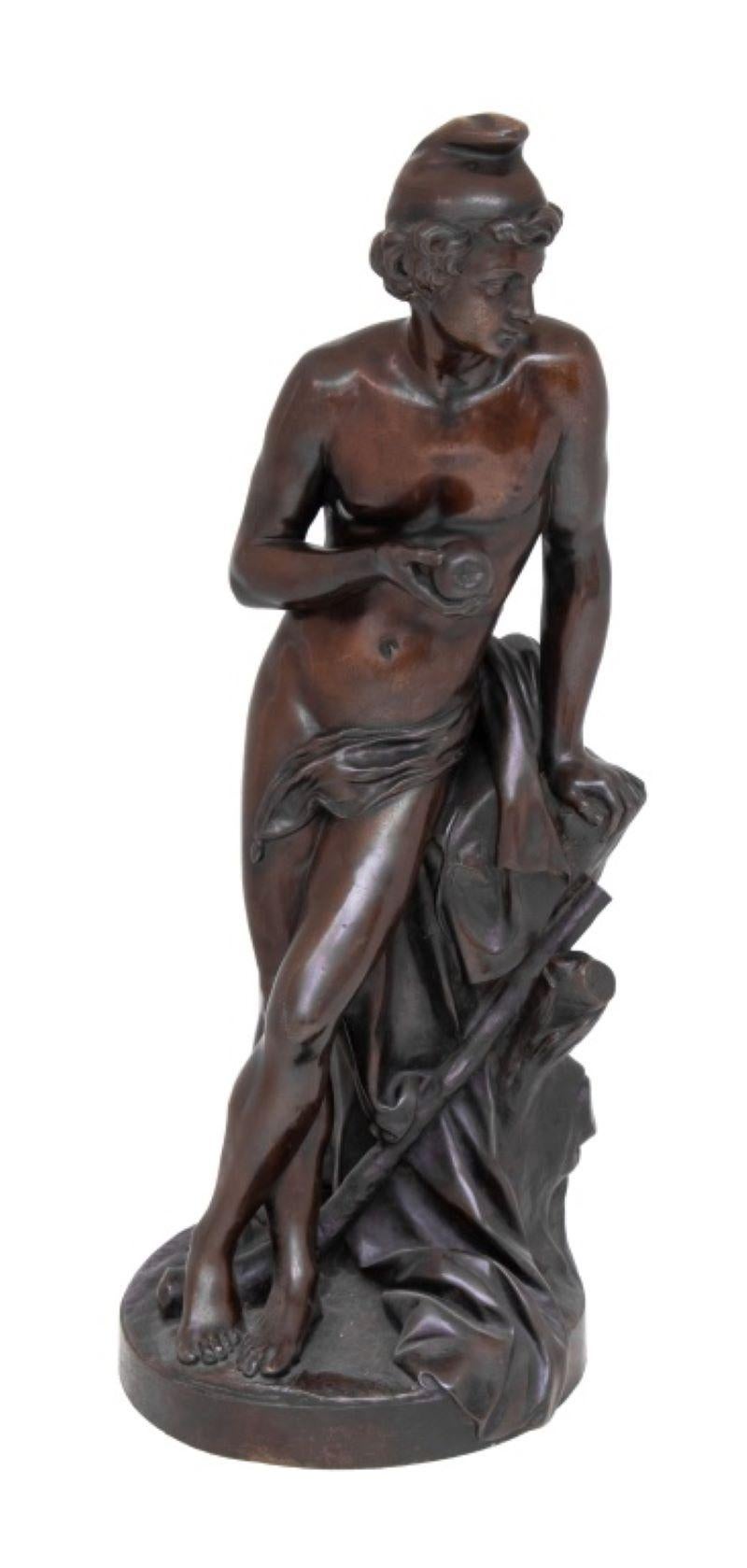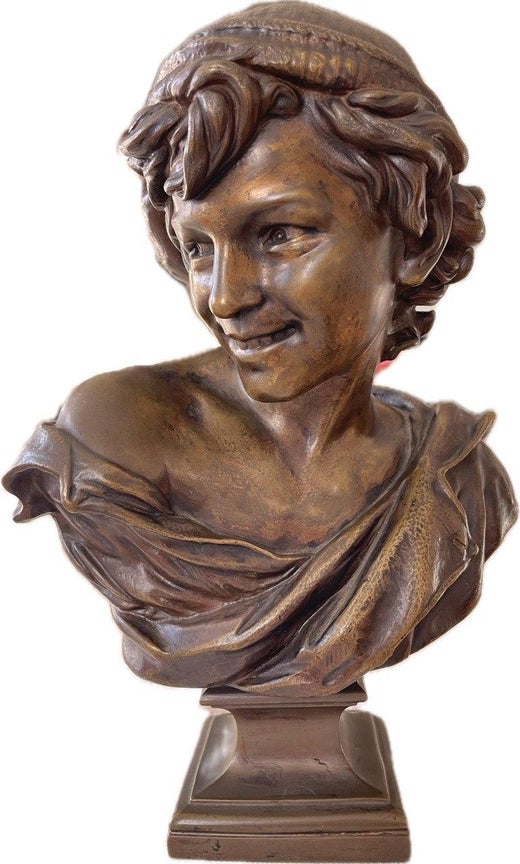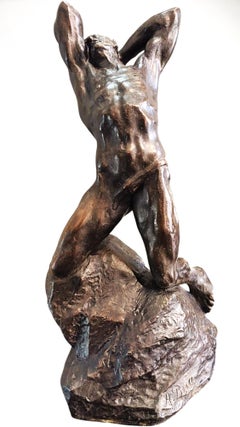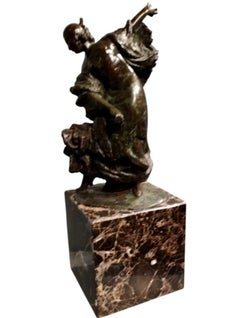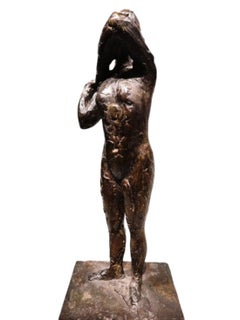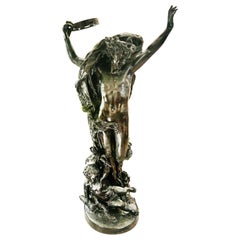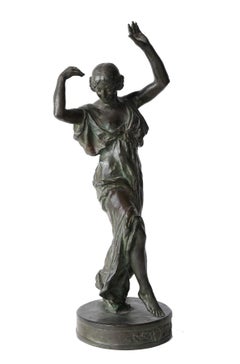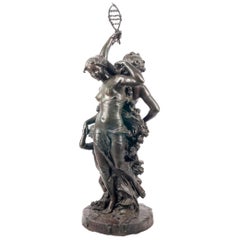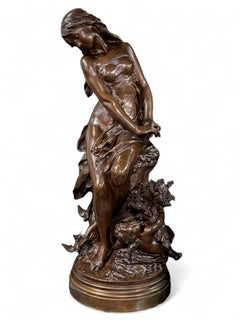Items Similar to The Spirit of Dance – Monumental Bronze Sculpture by Jean-Baptiste Carpeaux
Want more images or videos?
Request additional images or videos from the seller
1 of 14
Jean-Baptiste Carpeaux (1827-1875)The Spirit of Dance – Monumental Bronze Sculpture by Jean-Baptiste Carpeaux20th century
20th century
$70,887.16
£53,134.32
€60,000
CA$97,386.90
A$108,723.32
CHF 56,969.38
MX$1,330,880.11
NOK 723,511.73
SEK 682,179.70
DKK 456,741.89
Shipping
Retrieving quote...The 1stDibs Promise:
Authenticity Guarantee,
Money-Back Guarantee,
24-Hour Cancellation
About the Item
Three years after surprisingly winning the commission for the Paris Opera House—today known as the Palais Garnier—Charles Garnier entrusted one of the four major sculptural groups for its façade to his former classmate from the Petite-École and Prix de Rome laureate, Jean-Baptiste Carpeaux. After several proposals and many modifications, Carpeaux began work in 1868 on the stone version of La Danse.
His intention was to embody the very essence of dance—movement, joy, and exuberance. This sculpture immediately stood out among the more traditional architectural elements. The Spirit of Dance, the central figure in the composition, quickly became an icon of this monumental work.
Undecided on the gender of the “Genius of Dance,” Carpeaux chose the body of Sébastien Visat, a 20-year-old carpenter, for his healthy and slender physique. The figure’s radiant smile was borrowed from Princess Hélène de Racowitza. This unique combination resulted in a form brimming with life and delicacy—one of the most brilliant syntheses in Carpeaux’s career.
The figure is depicted in a whirling, triumphant pose, arms raised and holding a tambourine, symbol of music and celebration. His joyful expression and wind-swept hair convey a sense of freedom and ecstatic movement, contrasting sharply with the more rigid academic sculpture of the Second Empire.
Upon its public unveiling on July 27, 1869, the sculpture caused an immediate scandal. The press condemned this “wild dance of naked bodies” as indecent and offensive to public morality. One month later, the controversy still raging, a passerby hurled a bottle of ink at the sculpture, leaving a visible stain on the stone.
The rejection deeply affected Carpeaux. When Napoleon III, bowing to public pressure, considered having the sculpture removed, Carpeaux was devastated. Fortunately, the outbreak of war in 1870 prevented the removal, and the sculpture was spared.
This cast bears the prestigious mark of the Syndicat des Fabricants de Bronze, allowing it to be dated between 1909 and 1911. In 1909, Albert Susse was elected president of the Syndicate and worked to establish legislation protecting fine art bronze. He was joined by his son Jacques in 1904 and retired in 1911—bracketing the production date of this edition. This seal attests to both the provenance and exceptional quality of the casting.
Measuring 105.5 cm, this bronze is the largest of the known reproductions of The Spirit of Dance. Its monumental size makes it an exceptional and rare piece, produced in very limited numbers. Most other reductions are significantly smaller, making this version especially sought-after by collectors and museums. The scale allows for full appreciation of the details in the modeling, facial expressiveness, and the virtuosity of the drapery, all echoing the power of the original stone version.
The original work still graces the façade of the Opéra Garnier in Paris, and various bronze and plaster versions are held in prestigious museum collections:
Musée d'Orsay, Paris
Petit Palais, Paris
Musée des Beaux-Arts, Valenciennes
The Louvre, Paris
Metropolitan Museum of Art, New York
Victoria & Albert Museum, London
Today, The Spirit of Dance is regarded as one of the masterpieces of 19th-century sculpture, symbolizing the full expression of movement and vitality. Its influence can be seen in Art Nouveau, Symbolist sculpture, and even anticipates the expressive force of Rodin’s work.
With its unmatched dynamism and sculptural audacity, Carpeaux left a lasting mark on the history of art, inspiring generations of sculptors to capture the very soul of human movement.
- Creator:Jean-Baptiste Carpeaux (1827-1875) (1827 - 1875, French)
- Creation Year:20th century
- Dimensions:Height: 41.54 in (105.5 cm)Width: 29.14 in (74 cm)Depth: 0.4 in (1 cm)
- Medium:
- Period:
- Condition:
- Gallery Location:Gent, BE
- Reference Number:1stDibs: LU2140216201952
Jean-Baptiste Carpeaux (11 May 1827 – 12 October 1875) was a French sculptor and painter during the Second Empire under Napoleon III. Life Born in Valenciennes, Nord, son of a mason, his early studies were under François Rude.Carpeaux entered the École des Beaux-Arts in 1844 and won the Prix de Rome in 1854, and moving to Rome to find inspiration, he there studied the works of Michelangelo, Donatello and Verrocchio. Staying in Rome from 1854 to 1861, he obtained a taste for movement and spontaneity, which he joined with the great principles of baroque art. Carpeaux sought real life subjects in the streets and broke with the classical tradition. Carpeaux debuted at the Salon in 1853 exhibiting La Soumission d'Abd-el-Kader al'Empereur, a bas-relief in plaster that did not attract much attention. Carpeaux was an admirer of Napoléon III and followed him from city to city during Napoléon's official trip through the north of France. After initially not making any contact with the emperor, he finally succeeded in arranging a face-to-face encounter at Amiens where he managed to convince Napoléon to commission a marble statue that was to be carried out by a practitioner, Charles Romain Capellaro. Carpeaux soon grew tired of academicism and became a wanderer on the streets of Rome. He spent free time admiring the frescoes of Michelangelo at the Sistine Chapel. Carpeaux said, "When an artist feels pale and cold, he runs to Michelangelo in order to warm himself, as with the rays of the sun". While a student in Rome, Carpeaux submitted a plaster version of Pêcheur napolitain à la coquille, the Neapolitan Fisherboy, to the French Academy. He carved the marble version several years later, showing it in the Salon exhibition of 1863. It was purchased for Napoleon III's empress, Eugénie. The statue of the young smiling boy was very popular, and Carpeaux created a number of reproductions and variations in marble and bronze. There is a copy, for instance, in the Samuel H. Kress Collection in the National Gallery of Art in Washington, D.C. Some years later, he carved the Girl with a Shell, a similar study. In 1861, he made a bust of Princess Mathilde, and this later brought him several commissions from Napoleon III. Then in 1866, he established his own atelier in order to reproduce and make work on a grander scale. In 1866, he was made chevalier of the Legion of Honour. He employed his brother as the sales manager and made a calculated effort to produce work that would appeal to a larger audience.[3] On 12 October 1875, he died at George Barbu Știrbei's château in Bécon-les-Bruyères, outside Courbevoie. Among his students were Jules Dalou, Jean-Louis Forain and the American sculptor Olin Levi Warner.
About the Seller
5.0
Vetted Professional Seller
Every seller passes strict standards for authenticity and reliability
Established in 2018
1stDibs seller since 2022
5 sales on 1stDibs
Typical response time: 1 hour
- ShippingRetrieving quote...Shipping from: Gent, Belgium
- Return Policy
Authenticity Guarantee
In the unlikely event there’s an issue with an item’s authenticity, contact us within 1 year for a full refund. DetailsMoney-Back Guarantee
If your item is not as described, is damaged in transit, or does not arrive, contact us within 7 days for a full refund. Details24-Hour Cancellation
You have a 24-hour grace period in which to reconsider your purchase, with no questions asked.Vetted Professional Sellers
Our world-class sellers must adhere to strict standards for service and quality, maintaining the integrity of our listings.Price-Match Guarantee
If you find that a seller listed the same item for a lower price elsewhere, we’ll match it.Trusted Global Delivery
Our best-in-class carrier network provides specialized shipping options worldwide, including custom delivery.More From This Seller
View AllGeorges Flamand Bronze Danseuse (c. 1900–1910)
Located in Gent, VOV
This elegant and finely balanced bronze sculpture by Georges Flamand (1866 – ca. 1931) represents a Danseuse—a female dancer poised in a moment of lyrical movement, one arm arching g...
Category
20th Century Art Deco Nude Sculptures
Materials
Bronze
Extreme Effort - Powerful Bronze Sculpture by Alfredo Pina (1883-1966)
Located in Gent, VOV
Alfredo Pina’s Extreme Effort (Le Suprême Effort) is a striking bronze sculpture that embodies the raw struggle of human perseverance. This expressive work portrays a muscular male f...
Category
Early 20th Century Modern Nude Sculptures
Materials
Bronze
Danseuse de Flamenco – Bronze by Joanny Durand (1886–1955)
Located in Gent, VOV
This captivating bronze sculpture by French artist Joanny Durand (1886–1955) depicts a flamenco dancer in mid-motion, her body swirling with grace and energy. The composition capture...
Category
20th Century Art Nouveau Figurative Sculptures
Materials
Bronze
Dancer fastening the shoulder strap of her bodice – Edgar Degas, bronze cast by
By Edgar Degas
Located in Gent, VOV
A superb bronze cast of Edgar Degas’ iconic dancer, Danseuse agrafant l’épaulette de son corsage presents a moment of disarming intimacy: a young ballerina absorbed in adjusting the ...
Category
20th Century Modern Nude Sculptures
Materials
Bronze
Jeune Femme Debout, les Bras sur la Tête – Bronze by Henri Parayre (1879-1970)
Located in Gent, VOV
Henri Ernest Parayre’s Jeune femme debout les bras sur la tête is a striking embodiment of early 20th-century French sculpture, seamlessly blending classical inspiration with the eme...
Category
Early 20th Century Nude Sculptures
Materials
Bronze
Sokol-Athlete, a Sculpture of Movement and Strength by Jan Vítězslav Dušek
Located in Gent, VOV
Sokol-Athlete by Jan Vítězslav Dušek is a masterpiece of athletic dynamism, national pride, and sculptural ingenuity. Its exuberant motion, expressive anatomy, and symbolic power mak...
Category
20th Century Art Deco Nude Sculptures
Materials
Bronze
You May Also Like
Large Jean-Baptiste Carpeaux 1872 bronze "Le genie de la Danse" france.
By Jean-Baptiste Carpeaux
Located in Rio De Janeiro, RJ
Incredible rare and large bronze for JEAN-Baptiste CARPEAUX 1872 representing "Le GENIE de la Danse".
Category
Antique 1870s French Empire Figurative Sculptures
Materials
Bronze
Muse of Dance, Early 20th century French bronze sculpture of woman
Located in Beachwood, OH
Louis Armand Bardery (French, 1879-1952)
Muse of Dance
Bronze with green and brown patination
Signed and stamped with foundry mark
18 x 6 inches
Louis Armand Bardery was a student o...
Category
Early 20th Century Figurative Sculptures
Materials
Bronze
Classical C19th Bronze statue, depicting Music and Dance, JEAN-BAPTISTE GERMAIN
By Jean-Baptiste Germain
Located in Brighton, Sussex
A wonderful 19th Century bronze statue depicting Music and Dance, with two classical maidens and a child dancing.
Signed and stamped;
JEAN-BAPTISTE GERMAIN (FRENCH, 1841-1910)
Susse foundry mark 'Fonte sur Platre/ Susse Fres...
Category
Antique 19th Century French Figurative Sculptures
Materials
Bronze
Mathurin Moreau (1822-1912) Figural Bronze statue of The Allegory of Spring
By Mathurin Moreau
Located in New York, NY
Allegory of Spring
Mathurin Moreau (1822-1912)
A Belle Epoque bronze statue depicting an Allegory of Spring with a seated maiden looking over to view two birds as a putto gathers a...
Category
Late 19th Century Nude Sculptures
Materials
Bronze
19th Century Patinated Bronze Sculpture of a Dancing Female Figure
By Albert-Ernest Carrier-Belleuse
Located in Dublin 8, IE
19th century patinated bronze sculpture of a dancing female figure, possibly a sea nymph. The figure stands on a base of seashells and repouses twirling a drape around her body. It b...
Category
Antique 19th Century French Neoclassical Figurative Sculptures
Materials
Bronze
Émile Louis Picault Bronze Sculpture
By Émile Louis Picault
Located in Astoria, NY
Emile Louis Picault (French, 1833-1915) "Paris" Patinated Bronze Sculpture, late 19th century, the standing figure holding a golden apple, signed to base. 32" H x 12" W x 12" D. The ...
Category
Late 19th Century Art Nouveau Figurative Sculptures
Materials
Bronze
More Ways To Browse
Hair Sculpture
Bronze Dance Sculpture
Bronze Sculpture Dancers
Art Nouveau Bronze Sculptures
Bronze Cast Body Sculpture
Bronze Nude 20th Century
Bronze Architectural Model
Reproduction Bronze Sculpture
Bronze Nude Dancer
Life Size Plaster Sculpture
Napoleon Jacques
Art Nouveau Seal
Vintage Figural Bottles
Art Nouveau Bronze Nude
Three Graces Vintage
19th Century Life Size Bronze Sculpture
Plaster Louvre
Three Graces Sculpture
